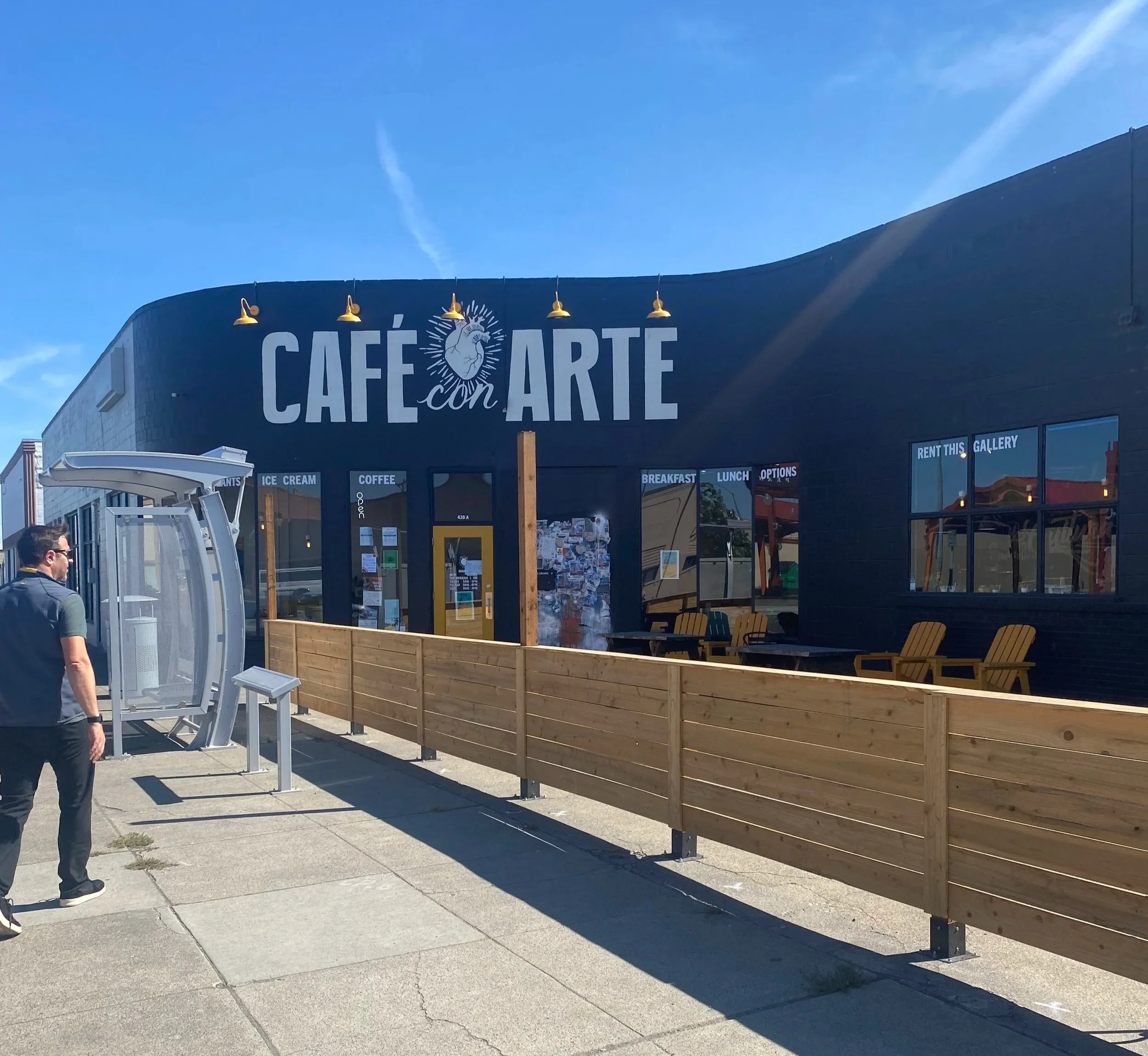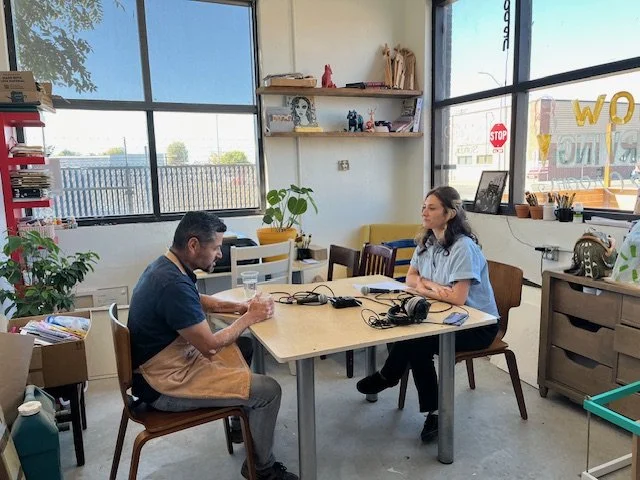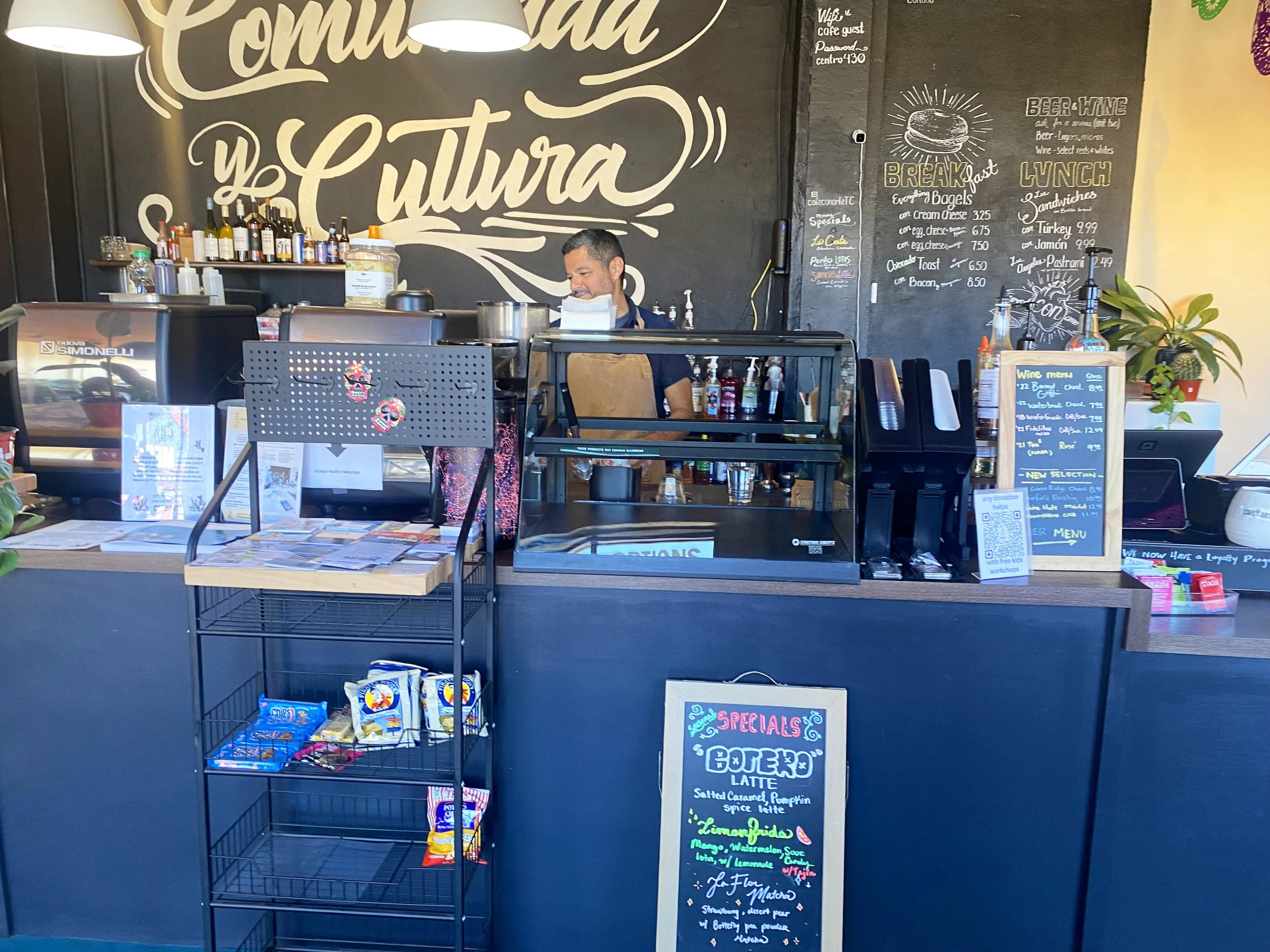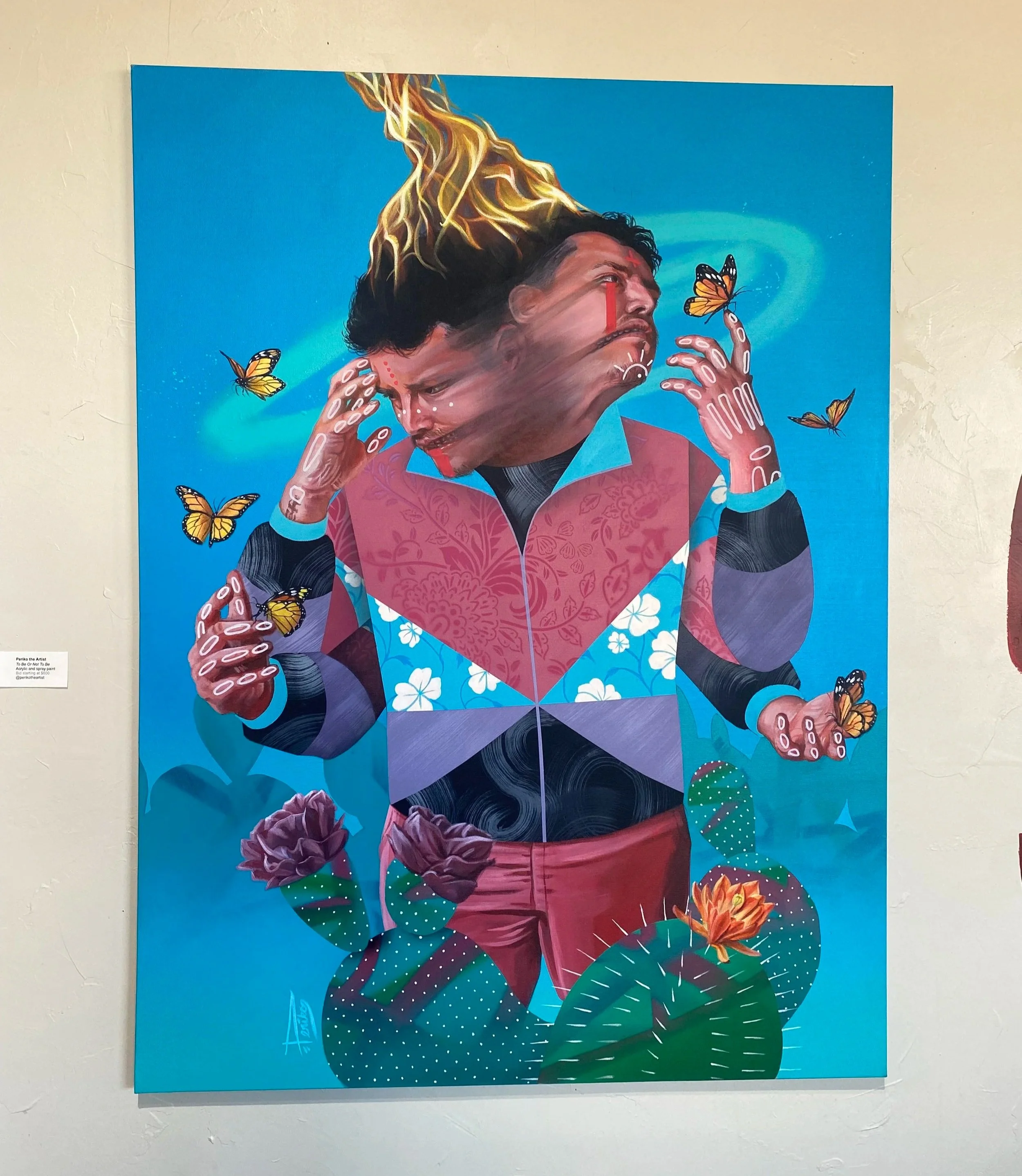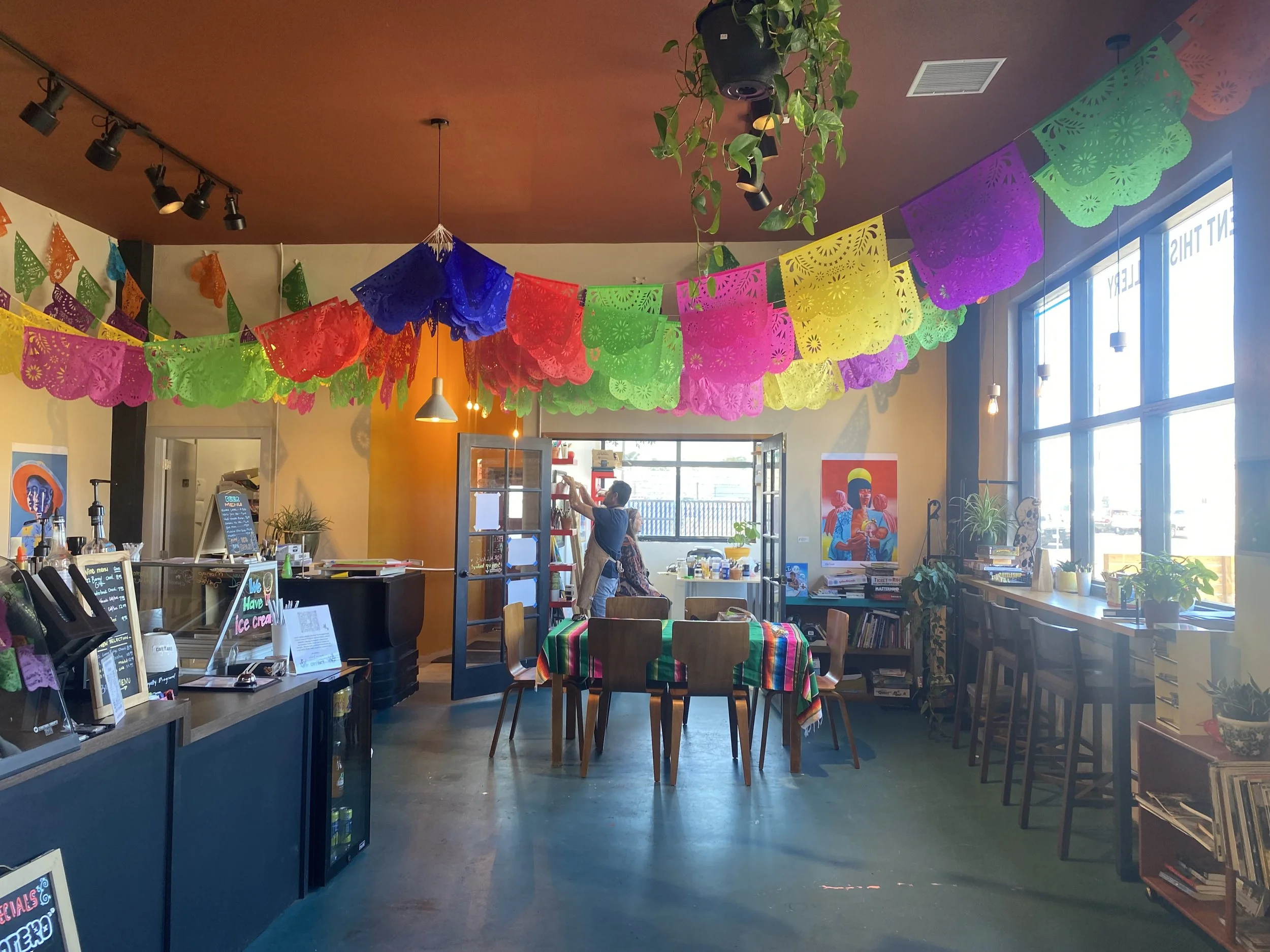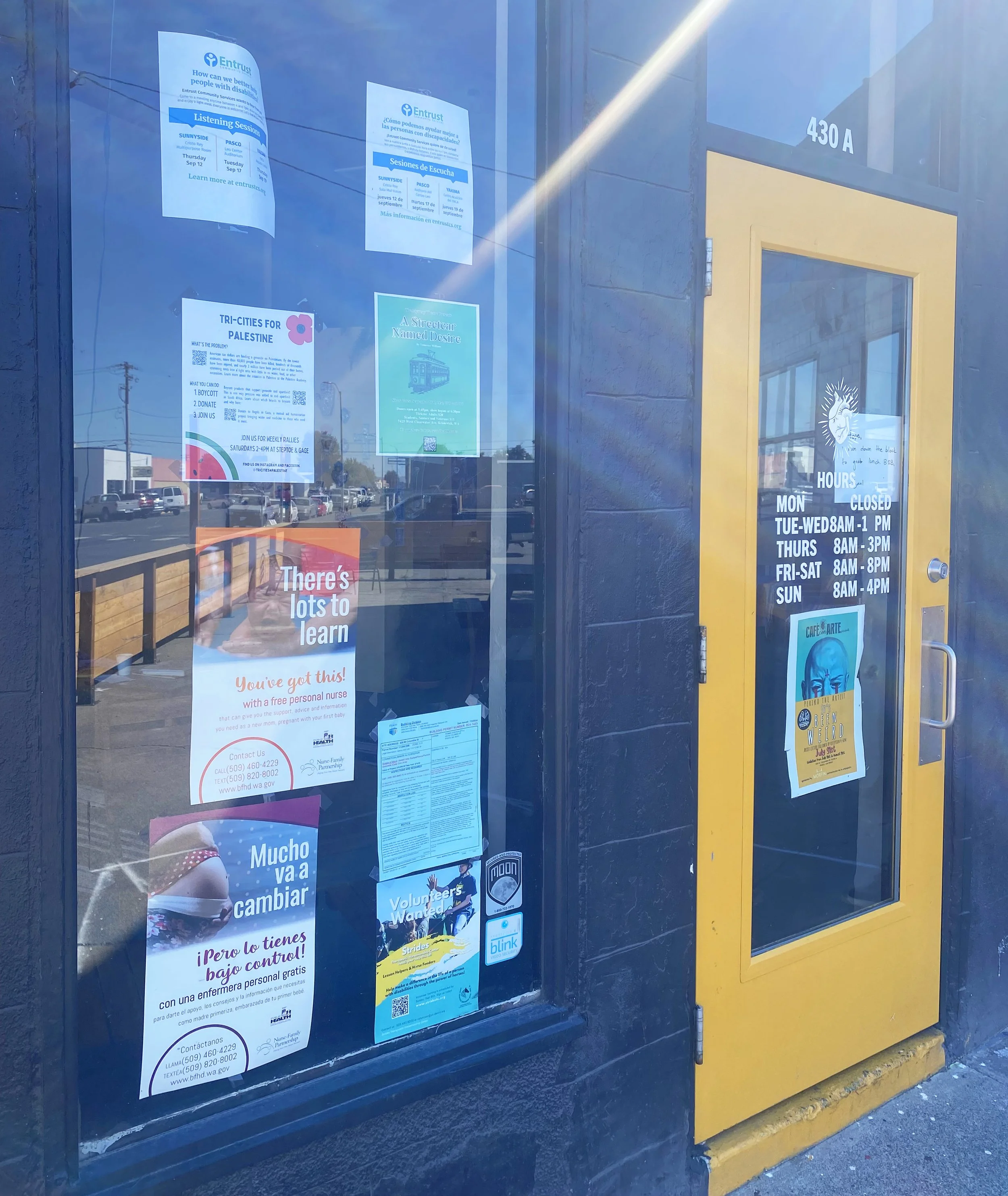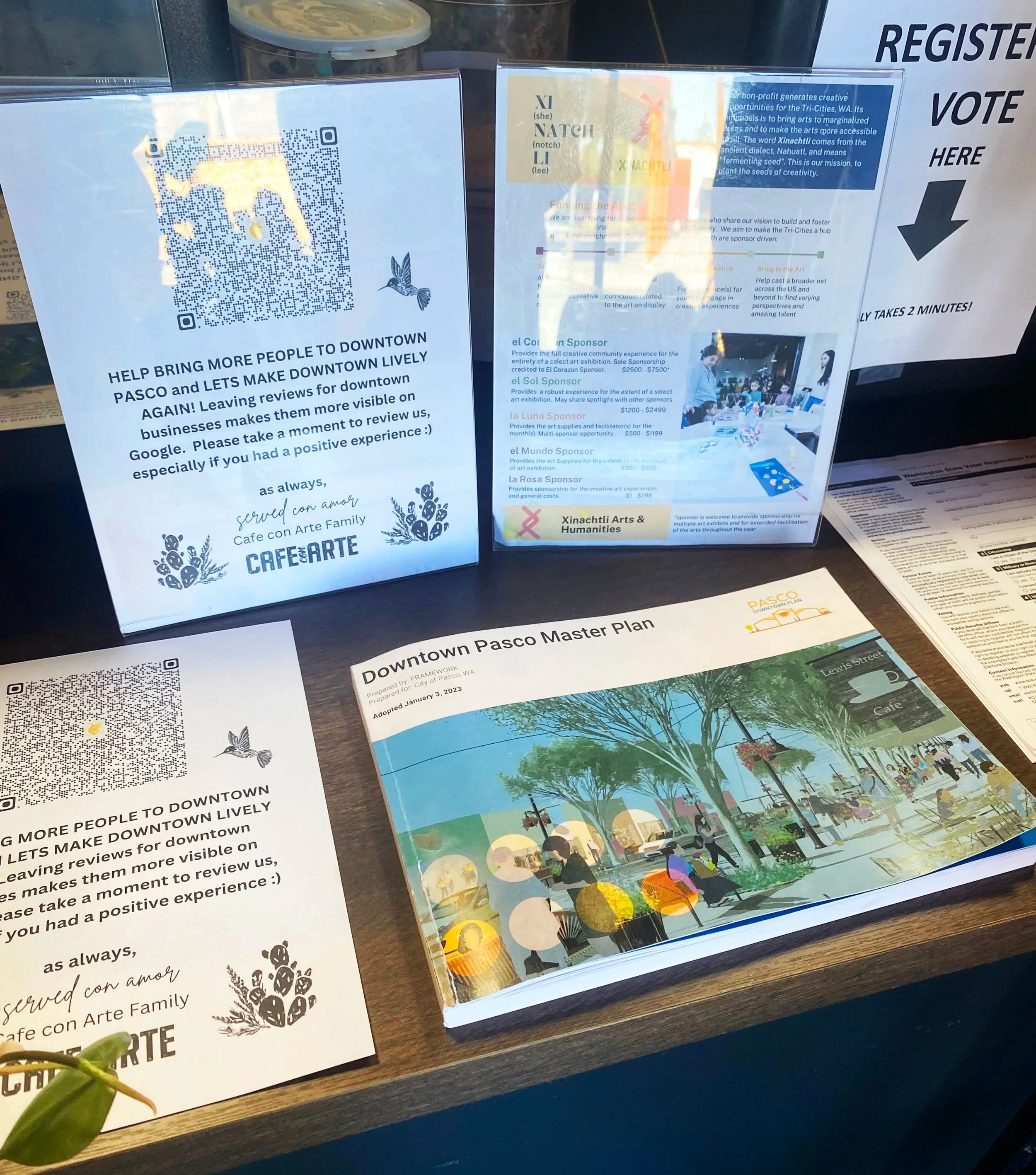making art downtown: a conversation with Pasco cafe owner Saul martinez
In the heart of Downtown Pasco lies a place where you can order a latte and leave with a new perception about what it means to create art. Owner Saul Martinez, art teacher and artist himself, has designed it that way.
Café Con Arte, was once a vacant building sitting right next to Peanuts Park, a flexible plaza and recent City investment. Every week, the plaza hosts the weekly farmers market, where hundreds of people buy and sell produce from eastern Washington's many farms. But during the week, it mirrors the rest of Downtown: it's a place that few choose to utilize, and some even avoid.
Framework's work to implement the Downtown Masterplan has been aimed at reversing this trend of inactivity through adaptive reuse of buildings, regular events, and better use of public space. Much of this work has been focused on updating codes and interpretations that create barriers. For example, when the Master Plan was adopted, a space like Saul's wasn't even legal — it took lifting parking requirements to allow the building to become a coffee shop. Of course, changing codes to allow new uses is just that start, and the community members like Saul, who are investing in Downtown Pasco, are at the core of its success.
We sat down with the cafe owner to talk about what drove him to quit a job where he could “finger paint all day if he wanted to” and plant roots in a Downtown that is struggling to ditch its reputation and blossom as a cultural hub. He talks to us about the potential for art to be a tool for youth empowerment in Pasco, and how he thinks the City could be support folks who want to take a chance Downtown. Enjoy an abridged version of our interview below!
Sitting Down with Saul
Saul cleared off a table full of art supplies to make room our recording equipment.
the origin of cafe con arte
FRAMEWORK:
You can introduce yourself however you want…
SAUL MARTINEZ:
My name is Saul Martinez. I am a Chicano artist and new business owner in downtown Pasco, Washington, which is on the east side of the state.
FRAMEWORK:
And we're here at Café con Arte, where you started this really cool thing in downtown Pasco. Can you talk about how this idea was conceptualized?
SAUL MARTINEZ:
Oh boy, those are kind words. I've been reflecting on this question a lot in the last eight months, and I used to just kind of simplify the answer to, "why not?"
I am an educator by trade, and so working with kids in this community, it just really broke my heart that they were embarrassed about the space that they were from — the East Pasco community.
When I first moved to Tri-Cities about 12 years ago, everybody was like, "Yeah, Tri-Cities is a great place to live and grow and raise kids. Just avoid East Pasco." And for the first two or three years, I actually listened to that advice. Even as a teacher here in Pasco, I would just never go to downtown East Pasco — until I did. And then it was just like, "Oh, why have I avoided it this whole time?"
It started with coming downtown more frequently with my art club. We were hanging Christmas lights and painting windows to beautify the area. And it was also just to put them out there so people could see that my New Horizons kids were amazing kids, because they are. I saw their aptitude. I saw their willingness to give back. It was just a beautiful thing.
There we would engage with all sorts of community members and leave with this impression of downtown Pasco as a diamond in the rough. Just somebody needed to activate it…
“The process that we use in the classroom—why can’t we use this in the community?”
From art teacher to cafe owner
SAUL MARTINEZ:
One thing that I noticed in my classroom was that the kids — even though they seemed to be proud of themselves — when they would talk, their body language spoke differently. You could see them walk down the hallways with a proverbial “tail between their legs.” They just seemed so embarrassed… My question in my classroom was: How do I change that? That was my focus mid-COVID.
I came to the realization that “dead art” wasn’t speaking to them. Why was I trying to teach them classical when all they cared about was hip hop, or country? So I started teaching them contemporary works, I started highlighting artists that were expressing their experiences in unique ways.
Immediately their conversations changed. They opened up a lot. They started talking about their own experiences. It was back and forth. No more monologue — we were having a conversation..
The process that we used in the classroom — why can’t we use this in the community? How can we further that conversation and start looking at ourselves through a lens of reverence, of being valued and celebrated?
That was that. Again, I went back to teaching and I thought that question would never resurface — until I met a person in the community named Alexia Estrada. Just a brilliant young lady with so much excitement about what this community could be.
She said, “I want a third space. I want a coffee shop in downtown Pasco.” We shook hands within the first 10 minutes and agreed that we were going to do something.
FRAMEWORK:
What I’m hearing is that you saw that contemporary art was missing from your student’s education but also from Pasco as a whole.
SAUL MARTINEZ:
Not missing, but maybe room for more.
If you look at more modern or previous art forms and movements, it was about capturing a moment. Contemporary art is more about speaking about our immediate needs — as individuals or as a community. It highlights what’s right, what’s wrong, and everything in between.
And as an artist, with great power comes great responsibility. It’s important to use your skill set to speak about the things happening in your community or beyond.
“‘Dead art’ was not really speaking to my kids. Why was I trying to teach them classical when all they cared about was hip hop, or country?”
“To Be Or Not To Be” by Periko the Artist, in acrylic and spray paint. Displayed at Cafe Con Arte in September 2024.
you caught me: I wanted a gallery
FRAMEWORK:
The room we’re sitting in has paper cups full of crayons, paint brushes, plants, chalk… Art is clearly happening here, it’s all over the walls. And before we started recording you cleared off the table, which had seemingly been the site of some kind of art making.
What’s happening here at Cafe Con Arte?
Saul Martinez:
You know, the big picture of Cafe Con Arte — I would call it a conceptual art piece.
If we go back to my kids and what I wanted them to see, I wanted to hold up a mirror and say, “Look at yourself. You are of value. You are worth anything and everything. You are visible, and I see you.”
I want that for the community, too.
FRAMEWORK:
From what I’m hearing, you saw this opportunity to nurture arts in Pasco, but you didn’t just open an art gallery, you opened a cafe…
SAUL MARTINEZ:
I wanted a gallery, you caught me. But I know what the art market looks like in the Tri-Cities, it’s almost nonexistent. You can count the galleries in the Tri-Cities – a population of 300,000 people – on one hand. How fair is that to a community? It’s embarrassing. I feel like it was a calling, a need. I wouldn’t say it was a dream, it was just like, I can’t go another day, another year, complaining about it. I have to do something about it.
The coffee shop? I have to pay the bills. In the Pacific Northwest, you can’t go a block without seeing a coffee shop, but drive around downtown Pasco and there were none. To me it’s a no brainer. And it’s just the beginning - I feel like, third spaces downtown – coffee, food, toys, games, books, events at night, that’s all going to be a part of it. It’s more than just coffee.
FRAMEWORK:
You’ve already been having art classes here, speakers… You’re doing a lot. What’s been the reception of those events?
SAUL MARTINEZ:
I’m trying a bit of everything… Just like we are teaching the community that we now have sit-down coffee in downtown Pasco, [we’re also] teaching people that paint-and-sips are a thing. People come in expecting paint-by-numbers, but that’s not what we do here! We’re gonna put you through a little stress because that’s growth, and you’re gonna love what you walk out of here with.
it’s time for us to be San Diego, Los Angeles, Santa Ana, Fort Lauderdale, or wherever… You can basically spin the globe, point, and find communities that have said enough! We can be who
we want to be!
PASCO’S IDENTITY AND VISION
FRAMEWORK:
Let’s talk about Pasco. Pasco has been working on changes downtown to make it a place where the culture is visible and people want to be. What makes Pasco’s culture unique?
SAUL MARTINEZ:
I think it’s the population, I think it’s the moment we’re in, where the community can choose what it wants to be. I don’t feel like it’s ever felt like it had the liberty to do so. For some reason it felt like it needed a top-down definition: This is who you are.
But with a 56% Latino demographic — maybe closer to 62% — it’s time for us to be San Diego, Los Angeles, Santa Ana, Fort Lauderdale, or wherever… You can basically spin the globe, point at it, and find communities that have said enough! We can be who we want to be! There’s no shame in that in fact, quite the opposite.
The Tri-Cities and Pasco, with this influx of transplants as well as people who have deep roots here, there’s this really cool opportunity.
FRAMEWORK: When you think about downtown Pasco and the changes you want to see, what does that look like?
SAUL MARTINEZ:
Vibrancy.
I want people to experiment with what a vacant lot can be. There’s so much repetition because it’s safe. I want people to take risks — throw that Hail Mary pass at a plant shop, or a tattoo parlor, an antique store — even if it might not work out in the immediate future.
People need those walking spaces between Café con Arte and the Italian restaurant right down the street. Another coffee shop, bring it! I think with more options, come more people, and more foot traffic… I welcome that.
I know what the art market looks like in the Tri-Cities, it’s almost nonexistent. You can count the galleries in the Tri-Cities – a population of 300,000 people – on one hand.
supporting third spaces
FRAMEWORK:
What could the city do to better support places like Café con Arte?
SAUL MARTINEZ:
Remove all restrictions. There are so many barriers, so many hoops to jump through. And when you get through those hoops you find mini hoops that you have to jump through.
There needs to be access – I’m sure there’s grants out there but as a one man show running Café Con Arte, by 11:30 or 12 a.m. when I’m done book keeping and it’s time to look for grants, I find myself asleep on the couch. There’s never enough time.
It would be great if someone had all the resources. I feel like a lot of organizations are doing similar stuff but they’re not connected.
And then there are the vacant lots — I can point to six vacant lots over here, three right next to me. I don’t think that attracts culture. I think we need to have these spaces filled, so looking at Vacancy Tax, or something like the program “Vacant to Vibrant” in San Francisco.
I think the City needs to be loud and clear about what they hope for from the community. I think they need to tell us that they’re stepping aside for creatives. I think we all have this creative nature about us, we are innovators. We just need to know that it’s a safe space for us to do so.
I have major faith in this community. There’s a lot of excitement and buzz around what Framework is helping to do and I think it’s only a matter of time.
“I think the City needs to be loud and clear about what they hope for from the community. I think they need to tell us that they’re stepping aside for creatives. I think we all have this creative nature about us, we are innovators. We just need to know that it’s a safe space
for us to do so.”
the plan
A copy of the Downtown Pasco Master Plan sits on the counter at Cafe Con Arte, reminding visitors that there is much in store for the future of Downtown.
Written by Hope Freije @Framework
What comes next? putting Pasco’s downtown plan into action
Framework had an exciting week at the Washington APA conference in Bellevue this past month! In addition to setting up an exhibit to share some of our recent projects and hosting two presentation sessions, we accepted an award for our downtown planning and implementation work with the City of Pasco. During the past few years that we have been working in Pasco, we have formed meaningful relationships with the community and have grown invested in the City’s success—we were honored that the project received an Excellence in Planning Award from the Washington Chapter of the American Planning Association (APA WA) and the Planning Association of Washington (PAW). We wanted to take a moment to talk about the process of writing and implementing this plan, and how we intend to continue to help the City achieve its goals through ongoing implementation efforts.
Award Ceremony
The team, including members from Framework and the City of Pasco, accepted the Excellence in Planning Award at the 2024 Washington APA conference.
downtown pasco
Downtown Pasco has many of the ingredients for a successful downtown: windowed storefronts lining 12’ sidewalks make for a walkable and engaging shopping experience; historic architecture creates a distinct character, including a brick post office and stucco former movie theater; more recently, the City invested in Peanuts Park, a central plaza with a structure for hosting weekly farmers markets.
Beyond the infrastructure, Pasco’s culture is also an asset to its Downtown. With a largely Spanish-speaking population and a strong relationship with its sister city Colima, Mexico, Pasco’s culture is visible in its yearly Cinco de Mayo Celebration and Fiery Foods Festival.
But between its weekly farmers markets and yearly festivals, Downtown often feels underutilized. Vacant buildings reveal a lack of investment. A lingering reputation as being unsafe deters people from choosing Downtown as their destination for social outings. And like many downtowns, it lacks housing and instead relies on commercial uses to generate foot traffic. These conditions make it difficult for local businesses to survive, furthering the cycle of disinvestment. The City decided to invest in a Master Plan to outline a strategy for reviving Downtown.
A Walkable Downtown
Windowed storefronts add interest along a fairly wide sidewalk.
Historic Architecture
Buildings such as the former Empire Theater create a mosaic of history and culture Downtown.
forming a vision
During public engagement efforts for the Downtown Master Planning process, people made it clear to us that they didn’t want a plan that would just sit on the shelves. They wanted to see a regular schedule of Downtown events, the addition of coffee shops and other places to spend time, and better uses of public space. They pointed out areas that could benefit from better lighting, decorative pavement, or pedestrian street closures to encourage more people to spend time Downtown. And they identified barriers such as outdated municipal codes and permitting processes, poor connection to the Columbia River, and a lack of services available for people struggling with poverty.
The engagement process was crucial not just for shaping the visions, goals, and strategies that formed the basis of the Plan, but for generating community capacity. Through the stakeholder meetings, visioning workshops, presentations to City Council, and outreach at events, we built relationships with Pasco residents and those invested in its success. These relationships have been key in helping us implement the community’s vision.
Vision of a Cafe with Outdoor Seating
The Master Plan envisioned an empty building across from Peanuts Park as a cafe with outdoor seating.
Vision Realized: Cafe con Arte
Updates to parking regulations permitted the use of this building as a cafe. The then-empty building has now been transformed into a coffee shop, art gallery, and community space by local high school art teacher and artist Saul Martinez.
the master plan
Rather than a plan view drawing that outlines a preferred layout for new development, Pasco’s plan takes the layers of Downtown and its stakeholders and devises a set of strategies for making steps toward attracting the investment of both money—in public private investments into buildings, businesses, and public space—and time— by encouraging people to spend time in Pasco’s Downtown. Four key visions guide a set of goals and strategies for improving public ways, attracting and guiding private investment, and developing collaborative and sustainable infrastructure for the care and management of Downtown.
For example, the vision of “Active + Safe Streets for All” means programming Peanuts Park for more regular use, right-sizing Downtown streets to make room for bike lanes and wider sidewalks, improving lighting, introducing parklets and other uses of public space, and creating a wayfinding program. These distinct approaches all contribute to streets that are regularly used for a variety of activities, which help people feel safe and comfortable using public spaces.
Visions, Goals, Strategies
Pasco’s Downtown Master Plan was designed to be actionable, with a matrix of action items that correlate with community-formed goals for the future of Downtown.
Implementing the Downtown Plan
After the Plan’s adoption in January 2024, the City hired us on to help make it happen. One of the first things we did was to update the municipal sign code to allow full scale murals on Downtown buildings. Murals were previously treated as signs and allowed to occupy only 25% of a building façade, limiting what people could create and causing tension around the removal of murals that did not meet this requirement.
Murals made sense as a place to start because of the priority residents placed around expressing Pasco’s culture and bringing more art Downtown. They also serve as way to revamp buildings and signal that Downtown is a place that is celebrated and taken care of. While in many cases, redevelopment and infill are not feasible, revamping existing buildings with murals is a relatively low-cost and low-barrier way to start investing into Downtown and breathing life into the public realm.
The City’s Arts Commission is now distributing grants to local businesses to commission murals on their buildings. There is a simple review process for murals concepts, which allows the City some amount of control, while overall leaving the vision up to the artist and the shop owner. So far the City has received two applications and murals are already underway!
Mural underway!
A new mural project commissioned as part of the Arts Commission’s grant program.
maximizing the use of downtown public space
Another strategy for accomplishing the Downtown vision was to “Update Codes for an Active Downtown.” This meant looking at ways that codes could encourage active uses of public space including food trucks, parklets, and events. With parking an issue that many brought up during the public engagement process, this also meant evaluating parking capacity and occupancy to make sure that these new uses of space didn’t impact people’s ability to park close to their Downtown destinations.
Before we made these code updates, food trucks in Pasco were prohibited from being within 400 feet of schools or 300 feet of restaurants or cafes, and had to move every hour. This made it infeasible for many mobile vendors to locate downtown, preventing them from activating space by offering destinations for food and drink within the public sphere. Food trucks have history in Pasco, and in general (beyond Pasco) there are opinions about whether they pose a threat to their brick-and-mortar counterparts. But in the end, Council agreed that imposing fewer restrictions on where and when food trucks can vend in public space would help to activate Downtown, support local businesses, and serve as another venue for sharing Pasco’s culture.
Council also approved updates to code to allow the conversion of parking spaces into café seating for use by adjacent bars and restaurants. This measure, popularized during Covid-19 lockdowns, offers businesses more space for seating while also bringing more people into the public realm. It is also a chance for businesses to get creative, adorning their “street cafes” with decorative lighting, flower boxes, or colorful fencing that can add the much-craved and ever-elusive “character” to a neighborhood.
Bringing mobile vendors downtown
Prior to code updates, mobile vendors couldn’t locate within 400 feet of schools or 300 feet of other bars, restaurants, or cafes.
Lighting, Safety, Activation
Vibrant public space hinges on people being out and visible, which also helps increase feelings of safety through those additional “eyes on the street” (in the words of foundational urban planning voice Jane Jacobs.) Fittingly, concerns around safety and a desire to see more events and activities downtown were both brought up during early public engagement efforts. Respondents also indicated a related desire for more and better lighting.
We wanted to learn more about how Downtown lighting could improve, so we organized a “Night Walk,” which was attended by police, councilmembers, City staff, and other Pasco residents. The group walked several blocks, observing both gaps in lighting and an abundance of bright security and roadway lights. While lighting wasn’t egregiously absent, there were clear ways that more consistent lighting with more character and quality would improve the experience of visiting Downtown Pasco at night.
Night Walk
Gathering people for a night walk allowed us to assess conditions and talk to people about their visions for better lighting Downtown.
While we fancy ourselves a team that can roll up our sleeves and learn something new, we decided to bring in some experts to help us outline a plan for illuminating Downtown. We worked with Blanca Lighting Design, who devised a strategy for adding lighting to storefronts, alleyways, and “gems”—historic buildings, public spaces, and other features that make Downtown Pasco unique. The Blanca Lighting Design team selected a suite of low-maintenance, high efficiency, and aesthetically pleasing fixtures that the City can use to fill in lighting gaps and create a nighttime streetscape that is legible, while still eclectic.
Because lighting is an ingredient that on its own will not fundamentally change the way Downtown functions, we also built a suite of activation strategies into this plan, which we have dubbed LAS Luces: Pasco’s Lighting, Safety, and Activation Plan. These activation strategies will focus on streamlining an events program to make best use of Peanuts Park and create a regular schedule of activity that can reliably draw people downtown.
Lighting, Safety, Activation
Pasco’s lighting plan aims to set the stage for a vibrant nighttime streetscape by adding layers of lighting to storefronts, historic buildings, and the street.
What's next
To determine how to move forward with our next year of implementation efforts, we met with residents, business owners, and City Council to get their feedback. During meetings, people brought out the Downtown Master Plan book, pointing to images and asking “how do we get this done?” They voiced a desire to see the Lighting Plan implemented, the need for increased capacity for City-run events, and the potential to redesign City-owned buildings and spaces Downtown to better support business growth, recreation, and community.
Currently we are working with the City to outline its top priorities. We hope to cross many things off the list: installing new light fixtures downtown, creating a regular events calendar, proposing designs for making the best use of new City-owned property…there is still much to be done! We are honored to move forward working with the City of Pasco to implement their vision, and we are continuously inspired by those who are invested in making Downtown Pasco a unique and beloved destination.
Written by Hope Freije @Framework


